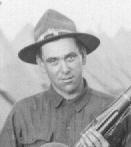 |
Commentary
Just a mule skinner.
My dad tells me that he was always under the impression that Grandpa was in the Supply company because he always said he was a "mule skinner" when asked what he did in the army. Well, he was transferred to the supply company and did drive mules as he states in his letter of Dec. 17th, 1918, but all through the war, he was in Company D and he carried a BAR (Browning Automatic Rifle). He saw front line action, and I believe avoided the discussion of it by saying, "I was a mule skinner."
Springfield Th is would be a US M1903 Caliber .30 "Spingfield",
the battle rifle of the US Army in WW I. This is probably the most accurate battle rifle ever built - perhaps the German Mauser would give it close competition. See m1903.com for more info. is would be a US M1903 Caliber .30 "Spingfield",
the battle rifle of the US Army in WW I. This is probably the most accurate battle rifle ever built - perhaps the German Mauser would give it close competition. See m1903.com for more info.
Automatic Rifle This was the Browning Automatic Rifle (BAR) M1918-A1. Designed by John Browning specifically for WW I. This was a very effective automatic rifle that was still being used in WW II. This fully automatic rifle provided the big advantage of having a lot of firepower and mobility. Prior to this, the only automatic weapons the Americans had were heavy machine guns that required a crew of two or three men to effectively operate. See http://www.firstworldwar.com/atoz/mgun_bar.htm for more details. Designed by John Browning specifically for WW I. This was a very effective automatic rifle that was still being used in WW II. This fully automatic rifle provided the big advantage of having a lot of firepower and mobility. Prior to this, the only automatic weapons the Americans had were heavy machine guns that required a crew of two or three men to effectively operate. See http://www.firstworldwar.com/atoz/mgun_bar.htm for more details.
4th Ohio to 166th Infantry, 42d Div.
The 42nd 'Rainbow' Division was organized by
combining National Guard units from 26 states and the District
of Columbia. The National Gu
42d - The Rainbow Division
 |
ard units from the other states included:
Louisiana Cavalry; 3d Battalion, 4th Pennsylvania Infantry; 69th
New York Infantry; 2nd Wisconsin Infantry Regiment ; Companies
B, C and F, Georgia Infantry; 4th Alabama Infantry; 3d Iowa
Infantry; 1st Illinois Field Artillery; 1st Minnesota Field
Artillery; 3d and 4th Companies, Maryland, C. A. C., forming
117th Trench Mortar Battery; 1st Separate Battalion, South
Carolina Engineers; 1st Separate Battalion, California
Engineers; Missouri Field Battalion, Signal Troops; Virginia C.
A. C. (Military Police); Engineers' Train, North Carolina;
Ammunition Train, Kansas; Supply Train, Texas; 1st Ambulance
Company, Michigan; 1st Ambulance Company, New Jersey; 1st
Ambulance Company, Tennessee; 1st Ambulance Company, Oklahoma;
1st Field Hospital Company, District of Columbia; 1st Field
Hospital Company, Nebraska; 1st Field Hospital Company,
Colorado; 1st Field Hospital Company, Oregon. The 'Rainbow'
Division would be assembled at Camp Mills, Mineola, Long Island
(New York) under the command of Major General William A. Mann.
I've just recently learned that Ohio state route 42 was named the Rainbow Soldiers Memorial Highway in 1947 (I found a copy of the dedication program in my grandfather's effects). This is a little ironic, as I live on Ohio Rt. 42 in Mansfield.
Camp Perry Camp Perry. located just West of Sandusky, Ohio, is still in existence today. It is the home of the Ohio Air National Guard Red Horse Construction Division, and the location of the Annual CMP (Civilian Marksmanship Program) National Matches. See http://www.cpmr-oh.org/index.htm
Ditching (Oct. 6, 1917 letter) He said a long hike was easy compared to "ditching". He was reffering to digging ditches for drainage tiles in farm fields. It was done by hand in those days, and he did it as a side job.
|